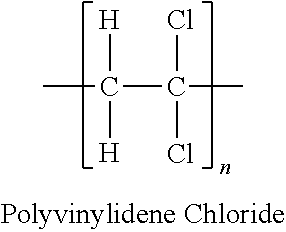Abbreviations PVDC | ||
Polyvinylidene chloride meaning
Polyvinylidene chloride (PVDC) is a homopolymer of vinylidene chloride.
Contents
- Polyvinylidene chloride meaning
- What does polyvinylidene chloride mean
- History
- Properties
- Fiber types
- Packaging
- Household
- Industry
- Miscellaneous
- Disadvantages
- Trademarks producers
- References
What does polyvinylidene chloride mean
History

Ralph Wiley accidentally discovered polyvinylidene chloride in 1933. He, then, was a college student who worked part-time at Dow Chemical lab as a dishwasher. While cleaning laboratory glassware, he came across a vial he could not scrub clean. Dow researchers made this material into a greasy, dark green film, first called "Eonite" and then "Saran".

Ralph Wiley went on to become one of Dow Chemical's research scientists and invent and develop many plastics, chemicals and production machines.

The military sprayed Saran on fighter planes to guard against salty sea spray, and carmakers used it for upholstery. Dow later devised a formulation of polyvinylidene chloride free of unpleasant odour and green colour.

The most well known use of polyvinylidene chloride came in 1953, when Saran Wrap, a plastic food wrap, was introduced. In 2004, however, the formula was changed to low-density polyethylene due to environmental concerns about its chlorine content.
Properties
It is a remarkable barrier against water, oxygen and aromas. It has a superior chemical resistance to alkalies and acids, is insoluble in oil and organic solvents, has very low moisture regain and is impervious to mold, bacteria, and insects. But it is soluble in polar solvents.
It has good thermal stability, but above 125 °C decomposes to produce HCl.
Fiber types
Saran fiber comes in monofilament, multifilament-twist, and as a staple fiber. It is also available in thermochromic (color changing) and luminescent (glow in the dark) fibers.
Packaging
Polyvinylidene chloride is applied as a water-based coating to other plastic films such as biaxially-oriented polypropylene (BOPP) and polyethylene terephthalate (PET). This coating increases the barrier properties of the film, reducing the permeability of the film to oxygen and flavours and thus extending the shelf life of the food inside the package. It can also impart a high-gloss finish, which may be aesthetically pleasing and also provides a high degree of scuff resistance to if applied over print.
Household
Cleaning cloths, filters, screens, tape, shower curtains, garden furniture.
Industry
Screens, artificial turf, waste-water treatment materials, underground materials.
Miscellaneous
Doll hair, stuffed animals, fabrics, fishnet, pyrotechnics, shoe insoles.
Disadvantages
While extremely useful as a food packaging agent, the major disadvantage of polyvinylidene chloride is that it will undergo thermally induced dehydrochlorination at temperatures very near to processing temperatures. This degradation easily propagates, leaving polyene sequences long enough to absorb visible light, and change the color of the material from colorless to an undesirable transparent brown (unacceptable for one of polyvinylidene chloride chief applications: food packaging). Therefore, there is a significant amount of product loss in the manufacturing process, which increases production and consumer costs.
